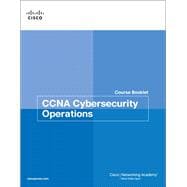Your Cisco Networking Academy Course Booklet is designed as a study resource you can easily read, highlight, and review on the go, wherever the Internet is not available or practical:
· The text is extracted directly, word-for-word, from the online course so you can highlight important points and take notes in the “Your Chapter Notes” section.
· Headings with the exact page correlations provide a quick reference to the online course for your classroom discussions and exam preparation.
· An icon system directs you to the online curriculum to take full advantage of the images embedded within the Networking Academy online course interface and reminds you to perform the labs, Class Activities, interactive activities, Packet Tracer activities, watch videos, and take the chapter quizzes and exams.
The Course Booklet is a basic, economical paper-based resource to help you succeed with the Cisco Networking Academy online course.








